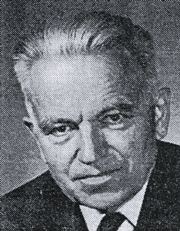

Gerhard Herzberg

Born December 25th, 1904, Hamburg, Germany.
Frederic Ives Medal and Honorary Member of the Optical Society of America. Honorary Fellow and Faraday Medal of the Royal Society of Chemistry. Nobel Prize. Earle K. Plyler Prize of the American Physical Society. Fellow of the Royal Society of London, Bakerian Lecture and Royal Medal. Foreign Associate of the National Academy of America. Honorary Member of the Japan Academy. Foreign Member of the American Philosophical Society.
Author of:
"Atomic Spectra and Atomic Structure"
"Molecular Spectra and Molecular Structure I. Spectra of Diatomic Molecules"
"Molecular Spectra and Molecular Structure II. Infrared and Raman Spectra of Polyatomic Molecules"
"Molecular Spectra and Molecular Structure III. Electronic Spectra and Electronic Structure of Polyatomic Molecules"
"Molecular Spectra and Molecular Structure IV. Constants of Diatomic Molecules"
"The Spectra and Structures of Simple Free Radicals: An introduction to Molecular Spectroscopy"
"Molecular Spectra and Molecular Structure I. Spectra of Diatomic Molecules"
"Molecular Spectra and Molecular Structure II. Infrared and Raman Spectra of Polyatomic Molecules"
"Molecular Spectra and Molecular Structure III. Electronic Spectra and Electronic Structure of Polyatomic Molecules"
"Molecular Spectra and Molecular Structure IV. Constants of Diatomic Molecules"
"The Spectra and Structures of Simple Free Radicals: An introduction to Molecular Spectroscopy"
Important Contributions:
Discovery of new spectra of known and (at the time) unknown diatomic molecules CO, N2, PN, CP, B2, H2, HD, D2 and others, and molecular ions especially CH+, and C2-. Observation of forbidden transitions of O2, CO and particularly H2 (the quadrupole infrared spectrum). Early (1929) recognition with Heitler from Rasetti's Raman spectra of N2 that the N nuclei obey Bose statistics, that is, that electrons are not present in nuclei, leading to Heisenberg's recognition that nuclei are made up of neutrons and protons. Study of the spectra of simple polyatomic molecules H2CO, C2H2, HCN, C3 etc. Use of isotope effect to establish their precise geometric structures. Herzberg–Teller selection rules for electronic transitions. First observation of -type doubling. Variation of C–C single bond distance depending on the nature of neighbouring bonds. Study of electronic spectra of simple free radicals : NH2, HCO, CH3, CH2, BH2 and others. First observation of Rydberg molecules especially H3 and NH4. Precise spectroscopic determination of dissociation energies especially of O2, H2, HD, D2 and of ionization potentials of H2 and D2, comparison with theoretical values. First experimental determination of the Lamb shifts of the ground states of the deuterium and helium atoms. Repeated contributions over many years to the study of predissociation.
An obituary can be found at
http://www.jstor.org/stable/pdf/3650221.pdf.